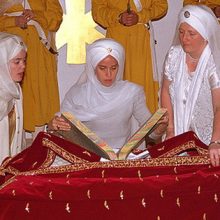by SS Hari Har Singh Burmeister, Hamburg, Germany Summer 2014 Compassion starts with ourselves. As simple as this may sound, I have often found myself engaged in old inner beliefs of “I have to”, “I should not”, mixed with subtle nuances of shame and blame towards myself and others. Our Master’s teachings—in all their high spirit and sacred intention—sometimes led me to more self-accusation. Sometimes we need to step out (at least in our mind) of old (inner) settings to be able to evolve. Sometimes a different approach helps. I have found this new approach in the practice of Nonviolent
Read More
Archives for Practices & Technology
Self-Compassion and Change
The Tools of Compassion
by SS Dr. Kartar Singh Khalsa, Santa Fe NM Summer 2014 In these difficult and challenging times it is important to remind ourselves of the tools we have been blessed to receive from the Siri Singh Sahib, our spiritual leader and teacher. One of the Aquarian sutras he gave us to survive and thrive in the midst of our challenges was: “Understand through compassion or you will misunderstand the times.” It’s the human condition: when we’re busy and stressed, we can forget to have compassion both for ourselves and for others who are struggling with life’s challenges. “Recognize the other person as yourself” is
Read More
Cultivating Compassion
by SS Dr. Shanti Shanti Kaur Khalsa, Espanola NM Summer 2014 “The only beautiful thing that makes you human is compassion. Think about vengeance, lies, truth, God, greatness, think of anything. If you take compassion out of it, everything becomes bitter. Compassion is a value of life; it is power; it is God and meditation; it is truth. Compassion gives you the strength to go through suffering and yet feel no pain. There is absolutely no grace without compassion.”—The Siri Singh Sahib (July 11, 1986) The capacity for compassion is innate in us as human beings. We are created with
Read More
Understanding Through Compassion
by SS GuruJivan Kaur Khalsa, Victoria, Australia Spring 2014 Guru Har Rai is the seventh Master in Sikh Dharma. He was the grandson of Guru Hargobind. He is known as the “tender-hearted” Guru. He was born in Kiratpur, India. His father was Guruditta Ji (son of Guru Hargobind Ji) and his mother was Mata Nihal Kaur ji. His wife was Mata Kishan Kaur Ji, also known as Mata Sulakhni Ji. After the battles and wars of Guru Hargobind’s time, the 7th Sikh Guru ushered in a time of healing and peace. Guru Hargobind instructed the boy that he should never
Read More
The Yoga of Compassion
by SS Krishna Singh Khalsa, Espanola NM Spring 2014 I have a deep appreciation for Guru Har Rai as a primary role model of human compassion. I also have a qualitative, causal understanding of myself through the Tantric Numerology system that we were taught by the Siri Singh Sahib. At one point in his teaching, he said that whenever you are counseling anyone, always start by understanding the numerology of that person. Guru Har Rai was the Seventh Guru. My numerological gift is the number 7, the Auric Body which essentially indicates the Crown Chakra. And the quality that we
Read More
Sow the Seed of Shabad Guru
by SS Deva Kaur Khalsa, Coral Springs FL Winter 2013 Bowing to another person often does not work well, due to human shortcomings, but bowing to an infinite, undying teacher—the Siri Guru Granth Sahib—can prevent the malady of spiritual ego. But even the Siri Singh Sahib, with all his caliber and consciousness, found it challenging to discover a way to deliver his students to the feet of the Siri Guru Granth Sahib. Because he loved the Siri Guru Granth Sahib, and his students loved him, the door was opened, and then he taught the powerful technology of Shabad Guru contained
Read More
A Sikh’s Relationship to Gurdwara
by SS Gurukirn Kaur Khalsa, Phoenix, AZ From the earliest days of his ministry, Guru Nanak’s approach to spreading his God-given message was very simple. Accompanied by his minstrel Mardana, he walked from village to village throughout much of India and many surrounding countries. There he would sit down under a tree, request Mardana to play, and begin to sing. His songs were filled with such poetic beauty and depth of meaning that the villagers could not help but gather around him and listen in awe.
Read More
Finding the Quiet
by SS Siri Ved Kaur Khalsa, Bakersfield CA Fall 2013 Finding the quiet center can take many years. Guru Hargobind’s example as the master of the Sixth Body offers an inspiration of how to find that “stillness” in the midst of life’s daily challenges. Here is a story of Siri Ved’s journey to find her “quiet center.” During the summer before my senior year in high school I read a book called The Master Game. It talked about different stages of spiritual awakening and how when one recognizes the need for a spiritual teacher she can consciously become a “magnetic
Read More
A Woman’s Arc Line
by Bhai Sahiba Dr. Bibi Inderjit Kaur Khalsa Fall 2013 What is the significance of a woman’s Arc Line? It is a woman’s Arc Line that gives her the strength to remain in the radiance of her dignity and nobility, even during the most dire tests and trials in life. A woman will rise to victory in every situation when she remembers she is sacred and divine. The Arc Line, or the Sixth Body, is a point of unification and integration between the spiritual and the material. There are three powerful mantras that can help us build a strong Arc Line.
Read More
The Soul of Sacrifice
by SS Amar Atma Singh Khalsa, Phoenix AZ Summer 2013 In January of 2009 I made my second trip to Amritsar. The sights, sounds, and senses of the Harimander Sahib called my heart and the blessings of its darshan was offered. My heart pounded with excitement as I arrived. The gold, the sarovar, the shimmery reflection, the kirtan, the coolness of the marble, and my head at the Parkarma formed an absolutely priceless experience. As I let myself be washed by the energy, my eyes drifted over the panorama of the Darbar. Hands folded, my eyes drifted and arrived at
Read More





















